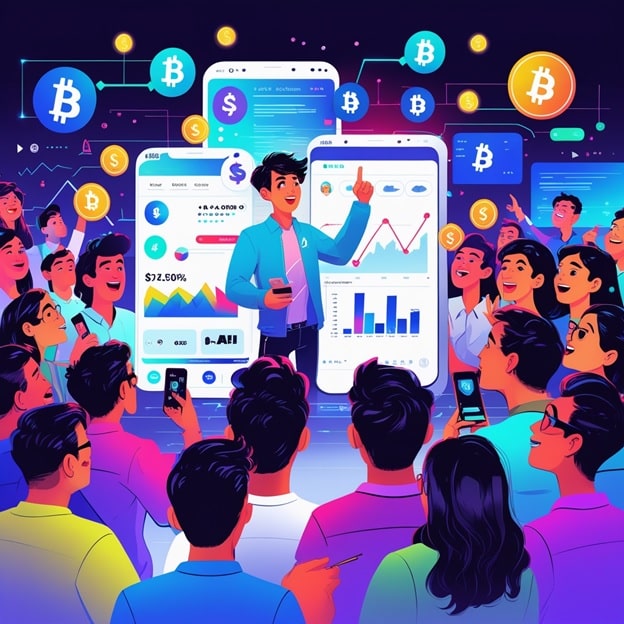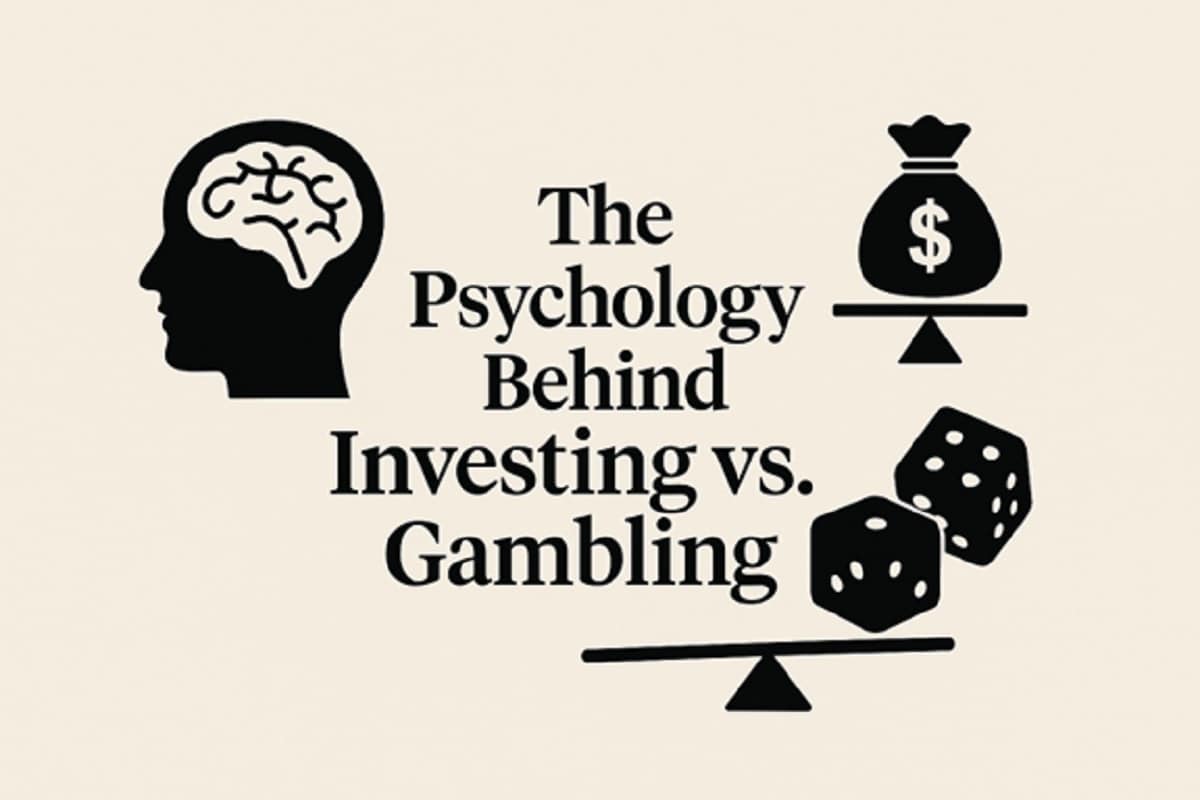Confused by market volatility? The investing platform of Social Trading Among Gen Z combines smart education with real-time community learning so members can invest through collective wisdom.
Introduction
New generations face additional obstacles when starting to invest because they experienced the financial crises alongside extensive student debt that coincided with the digital transformation of everything. Young investors currently find traditional investing platforms difficult to understand because these systems feel outdated along with their expensive nature and complex interfaces.
Social trading among Gen Z emerged as an influential new trend because of the broad changes in generational expectations. Young investors now utilize real-time monitoring platforms that allow them to learn from and duplicate successful peers because they prefer this social experience similar to how they engage with influencers on TikTok and YouTube.
Social trading provides Gen Z with mobile-friendly applications together with active community approaches and intuitive trading interfaces to create a collaborative financial journey for young investors.
What is Social Trading?
The modern investment technique of social trading uses online networking features to connect financial choices. Users can watch and replicate the trading approaches of professional investors using social trading while those methods are usually performed in real time. Novice traders using social trading platforms can easily track successful traders who share their best investment moves through simple user interface clicks.
The distinctive feature of social trading involves both complete visibility and user-friendly accessibility to its components. Users can view public investor profiles because these platforms show investors’ performance records as well as their risk tolerance thresholds and the way they break down their assets. Online traders who use social features can both create helpful comments regarding trade decisions and start new conversations or join existing trading discussions. This creates educational communities where users learn from each other.
The activity of social trading differs substantially from conventional investing because it depends on public trader portfolios alongside community-driven approach to strategy development and continuous market participation. The social trading concept eliminates both the solitary experience and the need for guessing because of these elements it connects with Generation Z strongly.
Why Gen Z is Drawn to Social Trading
Gen Z members experience life in an era marked by quick technological change and unending connectivity together with the desire to obtain social validation. Users of Instagram, TikTok and YouTube have formed their digital expectations based on the platform design elements of speed and sharing relationships with others. Traditional investment platforms, with their complex interfaces and dry data, feel outdated to this new generation of investors.
The fact that social trading appeals to Gen Z users is because its interface matches their interface preferences. The platforms enable users to experience familiar systems of feed navigation together with following established traders while interacting with real-time updates that allow users to share their own investment actions. This transformation makes personal investment more social by uniting it with shared activities between users.
Another key factor is trust. Gen Z individuals show greater trust toward their social connections and popular influencers ahead of institutional sources. Young users tend to trust the investment performance displayed by traders along with feedback from their communities and admired investors above traditional financial advisor services. The combination of fractional trading and user-friendly apps on investment platforms has lowered the initial investment requirements so more people than ever can access the market.
Social trading provides Gen Z members with instant investing access that meets their desire for interactive learning about finances in a completely personalized manner.
Key Platforms Fueling Social Trading Among Gen Z
The social trading sector has developed multiple platforms which appeal to Gen Z investors because they enable user-friendly community-based trading resources. Users benefit from platforms which allow them to trace successful traders and duplicate their investment methods while participating in live marketplace exchanges.
eToro
Worldwide investors consider eToro to be one of the most well-known social trading services and Gen Z investors show particular preference for this platform. Through its CopyTrading function the platform lets users duplicate trade activities of successful investors automatically. Users can interact socially through a feed area where they can post knowledge and ask queries and share methods for trading which suits students eager for social engagement.
Public.com
Public.com appeals to younger, socially conscious investors. This commission-free trading platform allows users to follow peers and professionals, and even share their portfolios with the community. Gen Z is particularly drawn to Public’s mission-driven approach, which includes giving users the option to invest in socially responsible stocks and cryptocurrency.
ZuluTrade
ZuluTrade lets seasoned traders and newcomers use its marketplace where they can find traders who offer different risk levels. Through ZuluTrade Gen Z investors can find suitable traders using performance metrics to copy their trade actions. The platform enables users to view the trading success ranks of their platform’s contributors and educares members through educational tools so they can enhance their trading competency.
Robinhood (Social Features)
Robinhood stands out for offering stocks without commissions yet its social attributes have recently gained prominence. People who use Robinhood can exchange trading information through their platform and everyone can read shared content and maintain a following network. Robinhood users benefit from an easy-to-use interface and social tools which draw youths from Gen Z to join its platform.
Virtual trading platforms increasingly determine the investment landscape through their mobile-focused business model and their approach that involves community-based activities. The platforms exist exactly how Gen Z members prefer social experiences because they rely on interactive peer-based interactions during the digital generation.
Pros and Cons of Social Trading for Gen Z
The financial approach of social trading provides various advantages to investors from the Gen Z generation since it has known limitations as any different investing method does. People need to understand all the benefits and drawbacks to successfully use this modern investment method.
✅ Advantages of Social Trading for Gen Z
- Access to Expert Strategies: Through social trading any person can access trading expertise previously available only to specialized experienced traders. New investors across Gen Z can duplicate the decisions of veteran traders by using social trading so they can replicate professional decisions without acquiring traditional market experience. Participating in financial markets becomes simpler through this method which eases the learning process.
- Low Barrier to Entry: Procedures linked to conventional investment typically demand large sums of money and sophisticated financial understanding. The social trading model enables users to make investments starting from small amounts or fractions of shares because of its accessibility benefits for entry-level investors. Users can experiment through platforms that provide no-cost trading facilities that minimize financial risks during testing periods.
- Community Support and Learning: Users enlarge their investing knowledge through the interactive characteristics of social trading. Platform members obtain immediate responses through direct interaction that involves question asking and insightful exchange. The communal structure fights against the loneliness which many Gen Z investors face during their exploration of complex financial market operations. Social learning functions on the platform create an educational experience better than conventional trading methods.
❌ Disadvantages of Social Trading for Gen Z
- Over Reliance on Others’ Strategies: There is an appeal to copying successful traders yet depending on this method exclusively carries significant dangers. Gen Z investors tend to miss evaluating trades independently because they do not possess strong critical thinking abilities. Traders who follow others without understanding underlying trade logic run the risk of repeating wrong decisions.
- Risk of Copying Poor Decisions: Users on social trading platforms can select top traders for observation but they cannot assure that every investment decision of these leading traders will succeed. Successful traders as well as beginners occasionally make mistakes during trading operations. Follower traders exposed to unsuccessful trades of their selected traders may encounter financial losses particularly when they do not fully comprehend all potential risks.
- Lack of Financial Literacy: Social trading on financial markets represents a key concern to Gen Z investors because they often lack complete knowledge about financial essentials. A major concern exists because numerous social trading users specifically younger investors, demonstrate limited understanding of investment market behavior together with risk control principles and spread investment strategies. Inadequate financial understanding among social traders leads to hasty financial choices which might result in money loss.
Though Gen Z investors find social trading appealing they need to mix their advantage of copy trading with thoughtful investment approaches and financial knowledge. Without grasping the serious risks involved investors place themselves at risk for making bad investment decisions over time by depending on the trades of others too frequently.
The Role of Influencers and Finfluencers
Social media influencers possess strong influence over their audience since their power reaches peak levels in platform-based trading experiences among Generation Z followers known as “influencers.”
How Influencers Shape Gen Z’s Investment Decisions
Twitter and Instagram and TikTok account holders share stock recommendations and investment knowledge with audiences along with showing their trading achievements. The deep connection Gen Z shares with social media makes them rely on influencers for financial advice above traditional financial advisors. The relatable and charismatic way they present technical information about finance helps young investors understand what initially seemed complex which drives them toward financial investment.
The Power of Social Proof
Gen Z followers connect with influencers because social proof appears as their primary attraction factor. Social media traders gain credibility with their followers when they provide investment strategies. Social proof helps followers gain confidence which makes them imitate these trading strategies despite their unawareness of hidden dangers.
Risks of Following influencers Blindly
The potential benefits of influencers education and motivation remain true but their general advice might mislead or over-simplify important information. The improper disclosure of critical information about risky stock options and cryptocurrencies as well as dangerous trading techniques characterizes certain financial influencers. Social media hype creates riskier choices that inexperienced traders make more often due to hasty decision-making that stems from the high-pressure environment.
Financial Literacy and Ethical Concerns
The main concern regarding influencers stems from their insufficient awareness about finances and unethical conduct. The majority of social trading platforms permit unskilled users to distribute investment advice and show their portfolio data to others.
Little to no accountability and regulation exist because of the lack of financial literacy and ethical responsibility which turns the platform into a misleading recommendations and scams breeding ground. Gen Z investors must show care when using influencers as investment advisors by validating received information alongside risk awareness.
The Positive Impact of Ethical Influencers
Certain influencers maintain their commitment toward promotion of responsible investing while teaching financial education to their audience. This type of influencer provides young investors with long-term investment strategies along with risk management practices that teach them valuable lessons. Gen Z individuals benefit from accessible content that helps them become more knowledgeable about finance because of these influencers.
The social trading behavior of Gen Z people receives both helpful and damaging influences through their interaction with influencers. Young investors should use inspirational material provided by influencers to build financial literacy while avoiding the practice of following trends without understanding their basics. People must use critical thinking skills together with trusted expert guidance to handle the responsible use of social trading platforms.
The Future of Social Trading Among Gen Z
The booming social trading among Generation Z marks the start of extensive changes in the financial market. The prospects for social trading become more promising because technology keeps improving while new platforms increasingly adapt to younger investor preferences. Gen Z investors have no clear direction for their financial futures. Let’s explore the potential developments.
Increased Integration of Artificial Intelligence (AI) and Automation
Social trading platforms will probably increase their use of artificial intelligence solutions and automation systems in upcoming developments. The analysis of market trends coupled with prediction making and tailored investment recommendations are functions which AI provides to social trading systems. The future could enable Gen Z investors to use smart investment tools that build trades from their specifications in addition to performing continuous adjustable portfolio management.
AI’s processing capability gets platform users hyper-personalized services because it predicts user responses to market conditions as well as strategic preferences. The deployment of investment recommendation tools enables Gen Z investors to lower their investment-related emotional responses while enhancing their trading strategy through better decision-making calculations.
Greater Focus on Social Responsibility and Ethical Investing
Generation Z values its support of social matters so it naturally applies this focus to its investment processes. Young investors now seek to combine investment decisions with their moral standards by investing in ESG stocks as well as socially-conscious investment alternatives. Future versions of social trading platforms will integrate sustainable investment opportunities that enable users to combine successful trader following with ethical business investment selections.
Platform transparency regarding investment destinations together with global impact effects on the world verge to become standard features. Gen Z’s preference for financially responsible investing that provides clear insights could shape the path social trading takes.
Growth of Cryptocurrency and Blockchain Integration
Social traders today frequently use cryptocurrency while experts believe Gen Z will maintain its growing interest in blockchain and digital currencies. Digital asset access through combined cryptocurrency trading options will soon be possible within social trading platforms because of upcoming integrations.
The social trading market stands to gain from blockchain implementation because it provides both security benefits and decentralized operations. Because blockchain enhances visibility it minimizes platform fraud and builds user confidence so the technology serves as an important resource for upcoming social trading systems.
Rise of Web 3.0 and Decentralized Finance (DeFi)
The internet evolution known as Web 3.0 will substantially influence the development path of social trading as its next major version. Gen Z investors are likely to choose decentralized finance DeFi platforms operating on blockchain infrastructure because they eliminate traditional banking or broker intermediaries. Investors would be able to eliminate middlemen by dealing directly with each other through this system and so control fees and costs.
Youths who possess expertise in technology combined with a preference for independence and security would find DeFi particularly useful because it gives them full control over assets and enhanced privacy. Social trading platforms are expected to embed DeFi technology so platform users can both track decentralized traders and conduct investments within blockchain assets.
More Regulation and Security
Higher levels of regulations and enhanced security safeguards must accompany the expanding popularity of social trading among members of Gen Z. Future regulatory guidelines will create tougher rules that protect users from deceptive and fraudulent practices through social trading platforms. Upgraded security measures such as multi-factor authentication and fraud prevention techniques will probably be added to social trading platforms to secure investments of users.
Social trading platforms should offer full disclosure about their top trader performance since this information needs to be authentic and non-deceptive.
What’s Next for Social Trading? Trends and Predictions
Social trading maintains considerable potential for growth throughout forthcoming times. Social trading platforms will advance through continuous development of artificial intelligence and blockchain technology combined with decentralized finance (DeFi). Gen Z leads an interest in ethical investing combined with transparent financial tools and digital tools that determines the emerging investment opportunities.
Social trading platforms must face strengthening regulations beside giving young investors proper financial training to allow them to make sound choices based on knowledge.Social trading among Gen Z describes an innovative approach to investing which joins financial education through technology while providing users a social environment for their investment choices.
For Gen Z members the platform serves multiple functions as a source of earning money and simultaneously shapes their financial understanding and simultaneously enables them to link with like-minded investors to generate future possibilities. This social trading movement launched by Gen Z will establish lasting effects on the direction investment will take in the future.
Conclusion
Social trading opened doors for Gen Z to revolutionize their investment behavior in a fundamental way. The current generation of young adults embraces technology and peer effects along with their need for financial independence to adopt interactive community-based investing platforms instead of traditional financial systems.
Although social trading gives these advantages to the users through its efficient learning platform alongside widespread inclusivity and enhanced social engagement the practice introduces issues such as irrational trades and deceptive information and dependent practices on uninfluential sources. Social trading platforms will become more complex because artificial intelligence and blockchain technologies along with decentralized finance are combining with their structure.
The responsible use of social trading technology by Gen Z depends on simultaneous growth of financial knowledge and ethical standards. Gen Z utilizes social trading as a revolutionary instrument that constructs their financial personality while building the path for global market investing of the future.


































